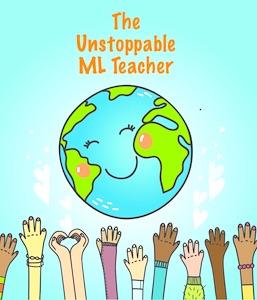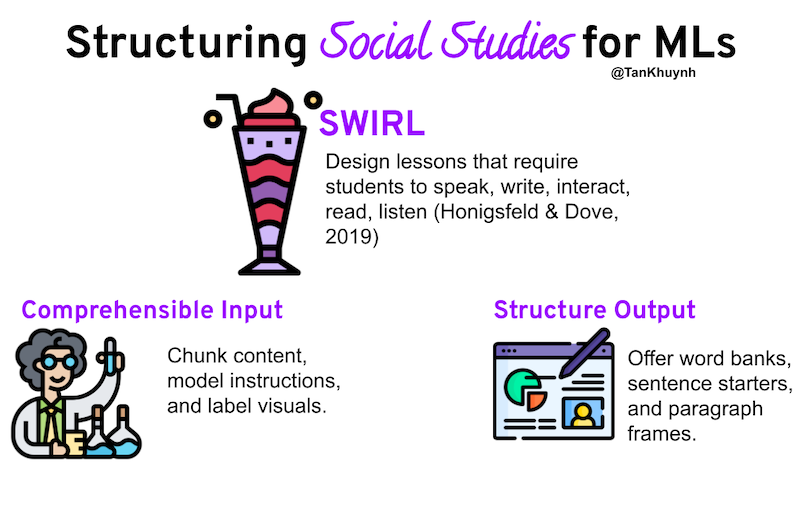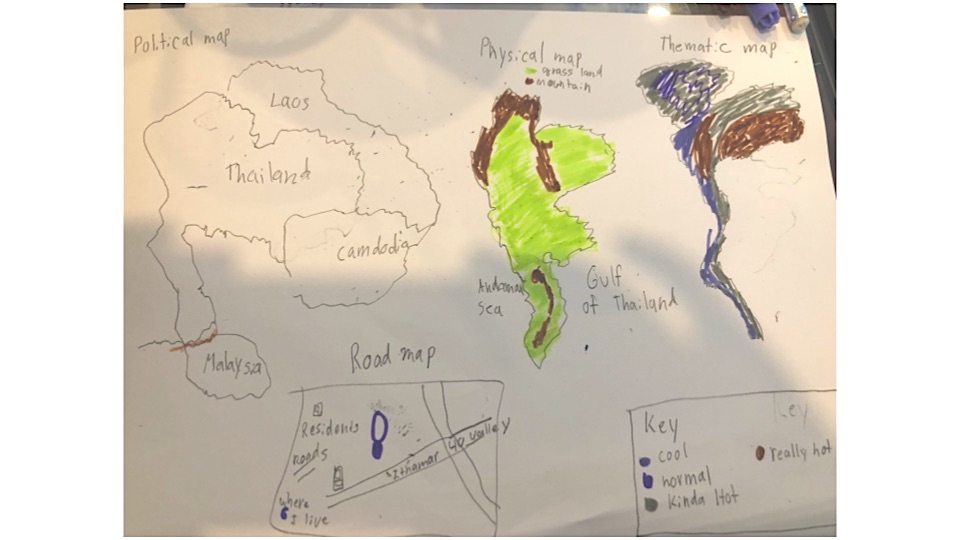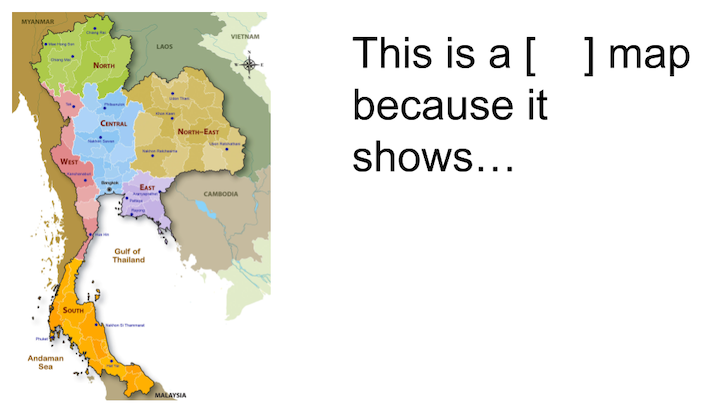How to Teach Academic Content to Multilinguals
A MiddleWeb Blog

When the opportunity to serve in the role of social studies teacher presented itself, I knew it could be a worthwhile undertaking along the path I have been following.
Now, after two years of learning to apply structures that support MLs to learn content as they develop language, I am a better content teacher and a more skillful language specialist.
In this article I share the essential lesson design components that support MLs in all content classes and offer a lesson plan from my own social studies classroom that I designed to teach content and language simultaneously.
SWIRL
The first component of making social studies accessible to students is to structure the class so students are doing most of the work. The least fruitful structure is when teachers talk at students the entire period. Instead of the teacher delivering social studies content, we have to move students to the center of learning by expecting them to process content (Snyder & Staehr Fenner, 2021).
Weaving all the language domains – speaking, writing, interacting, reading, and listening (SWIRL) – into a lesson ensures that social studies content is learned while language skills are also developed (Honigsfeld & Dove, 2019). For example, MLs can
● Collaboratively read an article and discuss it as they annotate each paragraph
● Collaboratively watch a video and co-write notes
● Collaboratively write a paragraph after reading an article, watching a video, or going through an experience
Though SWIRLing does take more time compared to direct instruction (lecture), MLs learn and retain the content at a much higher level because they are actively processing it themselves.
Comprehensible Input
When it’s absolutely necessary for teachers to provide short lectures to deliver social studies content, then we need to make the lectures comprehensible (Cummins & Early, 2015). Two of my favorite ways to do that are (1) chunking the content and (2) labeling visuals.
Chunking is when we segment the social studies concept into manageable units. It’s like a pod-style coffee maker – not a gushing soda fountain. Small amounts of content are delivered at an as-needed pace, and MLs interact with one concept before going to the next concept. The interaction can take any form such as a turn-and-talk or students taking sketchnotes during the lecture.
As teachers are delivering one concept at a time, they are presenting each concept with a rich visual that is labeled with the essential vocabulary (Calhoun, 1999). This makes social studies more accessible and directly teaches content-specific words.
Structured Output
Language is a two-way street. Students must communicate and not just receive messages. Content teachers need to structure the language that students must produce. There are three features of academic language: word, sentence, and discourse (Gottlieb & Ernst-Slavit, 2014). MLs need all three to communicate competently in social studies classes. Teachers can do the following to structure language at each of these levels:
● Word: provide labeled diagrams
● Sentence: draft sentence starters and sentence frames
● Discourse: teach transitions and provide an outline that states the sequence of ideas
When social studies teachers structure content-specific language in these ways, MLs develop the linguistic skills to communicate competently like historians and investigative journalists.
An Actual 3-Component Lesson
Now I want to walk you through an actual lesson that incorporates all three of these structures:
- SWIRL: integrating speaking, writing, interacting, reading, listening (Honigsfeld & Dove, 2019)
- Comprehensible input: making content understandable
- Structure output: scaffolding language production
This was a real 90-minute lesson I designed and deployed with my 6th graders. It was the first lesson in our Geography unit when I taught in Bangkok.
Objective: In a paragraph, describe the four types of maps we’ll be using.
Beginning
I asked students to take out their notebooks. I explained that we were going to take sketchnotes to help us learn about the four types of maps. Though there are many ways to teach the types of maps, I chose direct instruction this time. However, the lecture was quite short.
To make the lecture more comprehensible, I had students take sketchnotes. This is where I used SWIRL. Students listened to me describe each type of map, and they also wrote notes for each respective map. I had them label relevant parts of the map (e.g. bordering countries, mountains, rivers, a key, etc) to show the distinction between each map. The labeling helped teach the content at the word level (Calhoun, 1999; Gottlieb & Ernst-Slavit, 2014).
I chunked the lesson by showing students one type of map at a time instead of talking about all four without having students stop to process through sketchnoting. By chunking the content and processing our sketchnoting for each type of map, the concept became more comprehensible.
One example of the sketchnotes students took during the lesson depicting physical, political, thematic, and road type maps.
Middle
I placed posters of different map types around the room. Each poster also had a sentence starter: This is a [ ] map because it shows… The sentence starter structured language output at the sentence level (Gottlieb & Ernst-Slavit, 2014). This activity also incorporated the listening, speaking, and reading part of SWIRL. Students read the sentence starter aloud and filled in the appropriate blanks with their own responses. Students listened for missing details that could be added.
This is an example of one of the maps I posted around the room for the processing activity.
End
For the final 20 minutes of class, students worked in pairs to write a paragraph that described the four types of maps. They had to specifically describe each map by its distinctive features. In their groups I provided the following guiding questions:
- How many types of maps are there?
- What is the purpose of each map?
- What are the features of each map?
For extra support, I offered this optional paragraph frame to get students started. I did not offer the entire paragraph frame as the first few sentences model for students the writing they need to produce for the rest of the paragraph: There are [ ] types of maps, which are [ ]. The first type is [ ]. This map shows [ ]. To show this, the map uses [ ].
Both the guiding questions and the paragraph stems structured language output at the discourse level (Gottlieb & Ernst-Slavit, 2014). The sequence of ideas was clearly presented for students to follow. This closing activity also included SWIRL because students had to listen to each other’s ideas to successfully co-author a single paragraph. Their negotiation required speaking, listening, and interacting.
Analysis
This lesson was culturally responsive instruction for MLs because it was:
- student-centered
- simultaneously supporting and challenging students
- leveraging students’ cultural backgrounds (Snyder & Staehr Fenner, 2021).
When I taught each type of map, I used maps of Thailand because most of my students were Thai. This was assets-based instruction because Thailand’s maps are worth showing just like maps from Western countries.
However, when students were sketchnoting, I asked students to sketchnote maps for a country they are most familiar with. Students produced maps for places such as Great Britain/England, Australia, Myanmar, Japan, Poland, and China to name a few.
A ninety minute lesson is extremely long. At the end of this lesson, I overheard one of my students saying to another classmate, “That felt like 10 minutes.” The structures I used to design this lesson required students to stay actively engage, which helped time fly by.
We Create the Conditions
Teaching social studies (or any content) is less about receiving students who are ready to learn and more about creating the conditions that support student learning. When these components are present in our lessons, we create the optimal conditions for MLs to learn content and language simultaneously.
I often get asked if I have a template for planning lessons for MLs. Though I can share one, it’s more important to rely on the structures that create the conditions for MLs to learn.
When we begin our planning, let’s not look for boxes to fill in but instead let’s ask ourselves: How can I design a lesson that meets all three conditions that support learning?
While the content of a lesson changes daily, the conditions that make learning successful for MLs must remain unchanged.
Resources
Calhoun, E. (1999). Teaching beginning reading and writing with the picture word inductive model. Association For Supervision And Curriculum Development.
Cummins, J., & Early, M. (2015). Big ideas for expanding minds: teaching English language learners across the curriculum. Pearson Canada Inc.
Gottlieb, M. H., & Ernst-Slavit, G. (2014). Academic language in diverse classrooms : definitions and contexts. Corwin.
Honigsfeld, A., & Dove, M. G. (2019). Collaborating for English learners : a foundational guide to integrated practices. Corwin.
Snyder, S., & Staehr Fenner, D. (2021). Culturally responsive teaching for multilingual learners : tools for equity. Corwin.





































thank you thank you thank you thank you!!!!! I’m aware I need to work on my confidence when teaching my ML students. Resources like this, especially how you provided a sample lesson, are SO helpful.